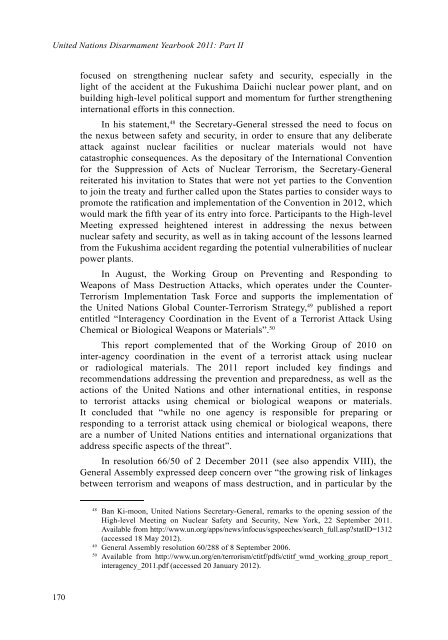DYB2011-Part-II-web
DYB2011-Part-II-web
DYB2011-Part-II-web
You also want an ePaper? Increase the reach of your titles
YUMPU automatically turns print PDFs into web optimized ePapers that Google loves.
United Nations Disarmament Yearbook 2011: <strong>Part</strong> <strong>II</strong><br />
170<br />
focused on strengthening nuclear safety and security, especially in the<br />
light of the accident at the Fukushima Daiichi nuclear power plant, and on<br />
building high-level political support and momentum for further strengthening<br />
international efforts in this connection.<br />
In his statement, 48 the Secretary-General stressed the need to focus on<br />
the nexus between safety and security, in order to ensure that any deliberate<br />
attack against nuclear facilities or nuclear materials would not have<br />
catastrophic consequences. As the depositary of the International Convention<br />
for the Suppression of Acts of Nuclear Terrorism, the Secretary-General<br />
reiterated his invitation to States that were not yet parties to the Convention<br />
to join the treaty and further called upon the States parties to consider ways to<br />
promote the ratification and implementation of the Convention in 2012, which<br />
would mark the fifth year of its entry into force. <strong>Part</strong>icipants to the High-level<br />
Meeting expressed heightened interest in addressing the nexus between<br />
nuclear safety and security, as well as in taking account of the lessons learned<br />
from the Fukushima accident regarding the potential vulnerabilities of nuclear<br />
power plants.<br />
In August, the Working Group on Preventing and Responding to<br />
Weapons of Mass Destruction Attacks, which operates under the Counter-<br />
Terrorism Implementation Task Force and supports the implementation of<br />
the United Nations Global Counter-Terrorism Strategy, 49 published a report<br />
entitled “Interagency Coordination in the Event of a Terrorist Attack Using<br />
Chemical or Biological Weapons or Materials”. 50<br />
This report complemented that of the Working Group of 2010 on<br />
inter-agency coordination in the event of a terrorist attack using nuclear<br />
or radiological materials. The 2011 report included key findings and<br />
recommendations addressing the prevention and preparedness, as well as the<br />
actions of the United Nations and other international entities, in response<br />
to terrorist attacks using chemical or biological weapons or materials.<br />
It concluded that “while no one agency is responsible for preparing or<br />
responding to a terrorist attack using chemical or biological weapons, there<br />
are a number of United Nations entities and international organizations that<br />
address specific aspects of the threat”.<br />
In resolution 66/50 of 2 December 2011 (see also appendix V<strong>II</strong>I), the<br />
General Assembly expressed deep concern over “the growing risk of linkages<br />
between terrorism and weapons of mass destruction, and in particular by the<br />
48 Ban Ki-moon, United Nations Secretary-General, remarks to the opening session of the<br />
High-level Meeting on Nuclear Safety and Security, New York, 22 September 2011.<br />
Available from http://www.un.org/apps/news/infocus/sgspeeches/search_full.asp?statID=1312<br />
(accessed 18 May 2012).<br />
49 General Assembly resolution 60/288 of 8 September 2006.<br />
50 Available from http://www.un.org/en/terrorism/ctitf/pdfs/ctitf_wmd_working_group_report_<br />
interagency_2011.pdf (accessed 20 January 2012).


